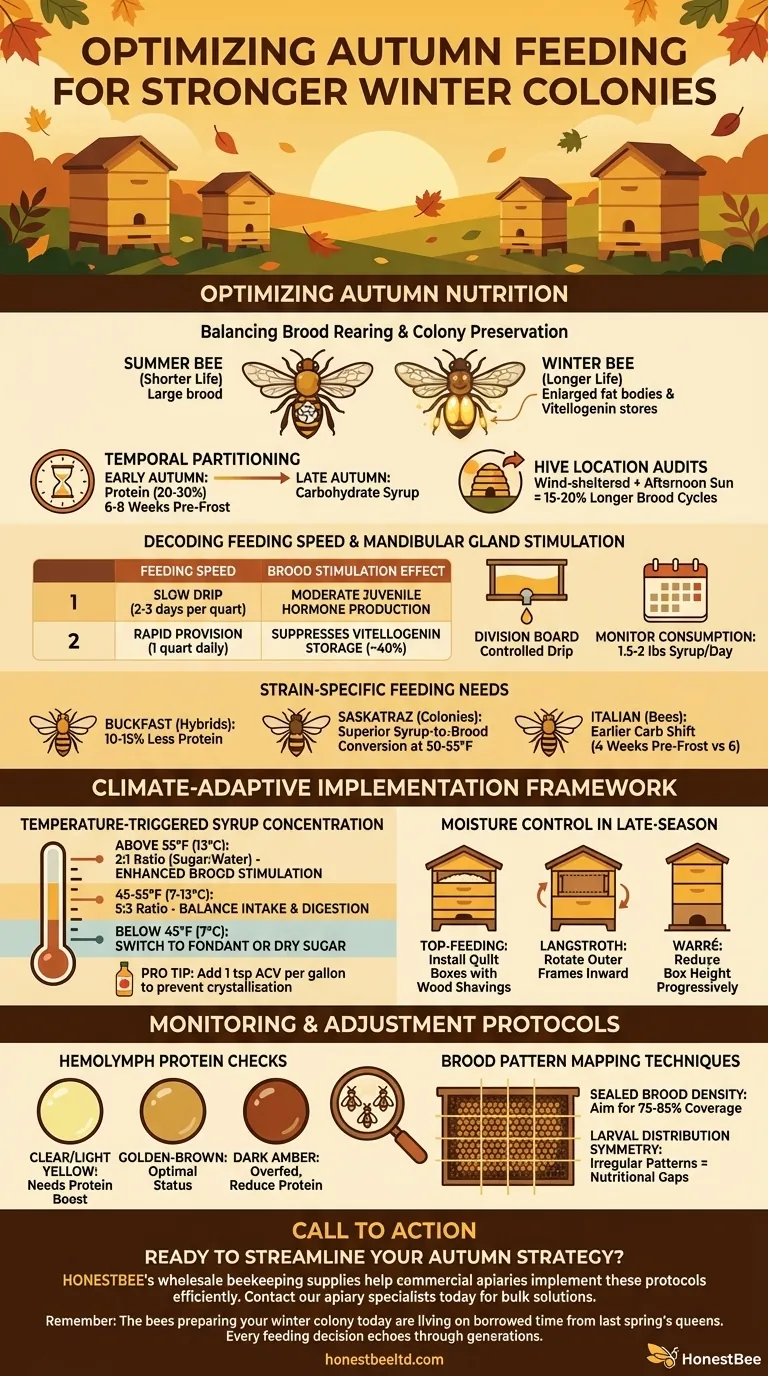Autumn feeding presents a critical balancing act for beekeepers: extending brood rearing to bolster colony populations while ensuring bees transition into winter-ready physiological states. This evidence-based guide explores climate-adaptive protocols to achieve both objectives, particularly for low-productivity colonies.
Optimizing Autumn Nutrition for Sustainable Brood Rearing
The Winter Bee Paradox: Brood Longevity vs Colony Preservation
Winter bees require distinct physiological traits—increased fat bodies and vitellogenin stores—to survive cold months. Yet autumn brood extension demands protein-rich diets that may compromise these adaptations. Research shows colonies fed moderate pollen substitutes (20-30% protein content) during early autumn maintain brood production without depleting worker bee longevity.
Key strategies:
- Temporal partitioning: Prioritize protein feeding in early autumn (6-8 weeks before first frost), shifting to carbohydrate-heavy syrup as temperatures drop
- Hive location audits: Colonies in wind-sheltered areas with afternoon sun exposure show 15-20% longer brood cycles
Decoding Feeding Speed: Mandibular Gland Stimulation Dynamics
The rate at which bees consume syrup directly impacts brood-rearing hormones. Studies of mandibular gland activity reveal:
| Feeding Speed | Brood Stimulation Effect |
|---|---|
| Slow drip (2-3 days per quart) | Triggers moderate juvenile hormone production |
| Rapid provision (1 quart daily) | Suppresses vitellogenin storage by ~40% |
Practical implementation:
- Use division board feeders for controlled intake
- Monitor consumption rates weekly—ideal is 1.5-2 lbs syrup per colony daily
Strain-Specific Feeding Calculators: From Buckfast to Saskatraz
Genetic variations significantly impact nutritional needs:
- Buckfast hybrids: Require 10-15% less autumn protein than Carniolans
- Saskatraz colonies: Show superior syrup-to-brood conversion at 50-55°F
- Italian bees: Need earlier carbohydrate shift (4 weeks pre-frost vs 6 for northern strains)
Climate-Adaptive Implementation Framework
Temperature-Triggered Syrup Concentration Adjustments
Syrup viscosity affects bee digestion efficiency during temperature swings:
| Ambient Temperature | Optimal Syrup Ratio (Sugar:Water) |
|---|---|
| Above 55°F (13°C) | 2:1 for enhanced brood stimulation |
| 45-55°F (7-13°C) | 5:3 to balance intake and digestion |
| Below 45°F (7°C) | Switch to fondant or dry sugar |
Pro tip: Add 1 tsp apple cider vinegar per gallon to prevent crystallization in cool temperatures.
Moisture Control in Late-Season Hive Topography
Excess humidity from autumn feeding can trigger dangerous condensation:
- Top-feeding colonies: Install quilt boxes with 2" wood shavings to absorb moisture
- Langstroth hives: Rotate outer frames inward periodically to prevent syrup mold
- Warré hives: Reduce box height progressively as temperatures drop
Monitoring and Adjustment Protocols
Hemolymph Protein Level Checks
A simple field test helps assess nutritional status:
- Collect 5 nurse bees from frame edges
- Observe hemolymph color under magnification:
- Clear/light yellow: Needs protein boost
- Golden-brown: Optimal status
- Dark amber: Overfed, reduce protein
Brood Pattern Mapping Techniques
Track feeding efficacy through systematic brood evaluation:
- Photograph same frame weekly using grid overlay
- Calculate:
- Sealed brood density (aim for 75-85% coverage)
- Larval distribution symmetry (irregular patterns indicate nutritional gaps)
Ready to streamline your autumn feeding strategy? HONESTBEE's wholesale beekeeping supplies help commercial apiaries implement these protocols efficiently—from precision feeders to climate-monitoring systems. Contact our apiary specialists today for bulk solutions tailored to your operation's scale.
Remember: The bees preparing your winter colony today are living on borrowed time from last spring's queens. Every feeding decision echoes through generations.
Visual Guide

Related Products
- Rapid Bee Feeder White Plastic 2L Round Top Feeder for 8 or 10-Frame Bee Hives
- Professional Hive Top Bee Feeder for Beekeeping
- Classic Boardman Entrance Bee Feeder Hive Front Feeding Solution
- HONESTBEE Entrance Bee Feeder Professional Hive Nutrition Solution for Beekeeping
- Professional Hive Front Entrance Bee Feeder
Related Articles
- How to Optimize Bee Colony Health: Science-Backed Feeding Strategies for Sustainable Buildup
- How to Successfully Introduce Queen Cells to Beehives: A Beekeeper’s Guide
- How to Boost Bee Colony Health with Natural Pollen: A Beekeeper’s Guide
- How to Choose the Right Bee Feeder: Matching Capacity and Feeding Rates to Your Hive
- How to Feed Bees During Shortages: Prevent Starvation and Sustain Colonies




















